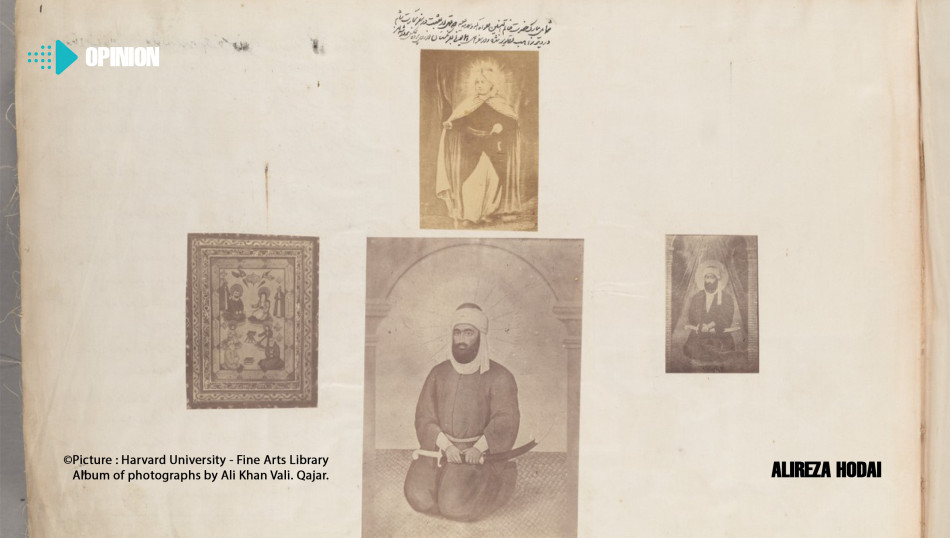The Visual Diary of a Qajar Governor: Ali Khan Vali and His Photography Album
The contemporary history of Iran largely consists of political narrations, stories, and scholarly works which were written due to the rapid changes in the political systemsof Iran. For a good number of decades,chroniclers, translators, and historians were occupied with political developments, political thoughts, and political histories that were largely not interested in cultural studies. Also, the lack of interest in cultural studies regardless of its reasons has left cultural studies in Iran mostly untouched and undiscovered. Iranian visual culture is among these topics that are not looked into, in which only a handful of these works are in Farsi English and Turkish is devoted to such an important field of study. A recently discovered digitized personal album is a concrete example of those understudied materials, in which is a visual diary of a Qajar governor, Ali Khan Vali, that is comprised of a large collection of rare photographs.
Who was Ali Khan Vali?
The historical sources associated to the life of Ali Khan Vali are very limited and mostly inaccurate and contradictory. Before the introduction of Ali Khan’s photography album digitized by Harvard University, he was an unknown figure only mentioned in a handful of historical accounts as a governor of some towns and cities during the late Qajar era. He was born in the mid-19th century in Tehran and was one of the grandsons of Dost Ali Khan, known as Moayyir al-Mamalik, a prominent member of the Qajar Royal Family who served as an envoy and as the head of treasury. Ali Khan’s father, Qasim Khan, who later became the first ambassador of the Qajars in the Russian Empire, took Ali Khan with him in most of his travels to the Russian Empire and the cities of Tiflis and St. Petersburg where he learned foreign languages and the art of photography. After Ali Khan returned from St. Petersburg,he heldoffice as the governor in multiple towns’uch as:Khoy, Urmia, and Rasht. Ali Khan’s son, Qasim, who was named after his grandfather and became known as SardarHomayun, was the first mayor of Tabriz and was an important military figure during the late Qajar era, as well as, the first Pahlavi reign. There are not enough details on his death but, apparently Ali Khan Vali died in the early years of the 20th century and was buried in the city of Qom. His royal family is known to be devoted to art and culture, as there are a number of books and buildings attributed to them.
Ali Khans’sPhotography Album and its Significance
The visual material of Iran up until the late Qajar era are often made up of scattered pieces of sketches or single photos taken by travelers, orientalists, and/or statesmen who were on official visits to Iran. Early examples of these photographs taken in Iran coincide with the reign of Nasir al-Din Shah, with a collection attributed to the Venetian Luigi Pesce which dates back to the 1850’s. However, historical sources speak of photographs and photographers that can be traced back earlier than this date, but not much has survived apart from a few single photograph examples that are available online. Nasri al-Din shah himself is known to be an example of the first photographers in Iran, on the other hand none of these rare works on visual culture of Iran have listed Ali Khan Vali as a photographer nor has his photos appeared in textual material. This might be due the fact that the album was kept in family and personal archives until it became public in 2007. Nevertheless, Ali Khan’s collection is the first organized collection of Iranian photography and Ali Khan himself deserves to be credited as the pioneer of Iranian photography. His album is a unique collection that has over 1000 photos of people, towns, cities, and natural landscapesof Iran until the1900s. To add on, some of the photographs taken by Ali Khan are from remote places and rare locations. His photos were the only visual material available until the 1950s.. Furthermore, the album is also a great source foranthropology, as it bears a lot captioned details on the demography and on the landscapes of Iran which descriptions are provided by the author. There are few books published in Iran on this album, but certainly there is more room available for scholarly work to be implemented on Ali Khan’s life, his album, and his art of photography.
Disclaimer: If you want to access the photographs described in this article, you can reach the album from the Library archive of Harvard University: https://iiif.lib.harvard.edu/manifests/view/drs:6665026$430i and the copyright of images belong to their respective owners.
- Tags:
- Culture
- Photography
- Ali Khan Vali











